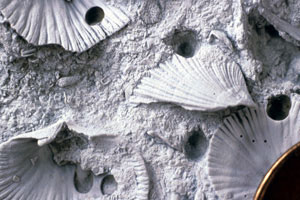Bioerosion
Bioerosion is the process by which biological activity causes the erosion and breakdown of materials, particularly in the context of rocks, coral reefs, and other marine and freshwater environments. This process is significant in shaping landscapes, forming soil, and in the ecosystem dynamics of aquatic environments. Bioerosion is caused by various organisms, including bacteria, plants, fungi, and animals. These organisms can erode materials through physical means, such as the boring and grazing activities of certain marine invertebrates, or through chemical means, such as the production of acids that dissolve rock or coral.
Mechanisms of Bioerosion[edit | edit source]
Bioerosion occurs through several mechanisms, each involving different agents and processes. The primary mechanisms include:
- Mechanical bioerosion: This involves the physical breakdown of substrates by organisms. Examples include the burrowing activities of sponges, worms, and bivalves in marine environments, which can weaken and eventually break down rock and coral structures.
- Chemical bioerosion: Organisms such as lichens on terrestrial surfaces and microorganisms in aquatic environments can produce acids or other chemical compounds that dissolve rocks and minerals. This process can lead to significant alterations in the chemical composition and physical structure of the eroded material.
- Biological corrosion: This refers to the process by which coral and other calcium carbonate-based materials are eroded by the action of certain algae and fungi. These organisms can penetrate and dissolve calcium carbonate, contributing to the degradation of coral reefs and other marine calcareous structures.
Impact of Bioerosion[edit | edit source]
Bioerosion plays a crucial role in the ecology and geology of marine and terrestrial environments. Its impacts include:
- Formation and maintenance of habitats: Bioerosion contributes to the creation and development of habitats such as coral reefs and rocky shores, which support diverse ecosystems.
- Nutrient cycling: By breaking down materials, bioerosion facilitates the release and recycling of nutrients, which is essential for the productivity of ecosystems.
- Geological and landscape changes: Bioerosion influences the shaping of landscapes and the formation of geological features over time, including the erosion of cliffs, the creation of caves, and the development of soil profiles.
Bioerosion in Coral Reefs[edit | edit source]
Coral reefs are particularly affected by bioerosion, which can have both positive and negative impacts on reef ecosystems. On one hand, bioerosion is necessary for the natural maintenance and recycling of coral reef structures, providing spaces for new coral growth and contributing to the dynamic balance of reef ecosystems. On the other hand, excessive bioerosion, often exacerbated by human activities and climate change, can lead to the degradation and loss of coral reef habitats, with significant implications for biodiversity and human societies that rely on reef ecosystems for food, protection, and income.
Conservation and Management[edit | edit source]
The conservation and management of bioerosion processes are critical for the preservation of natural habitats and the protection of biodiversity. Efforts to mitigate the negative impacts of bioerosion include the protection of vulnerable ecosystems, the restoration of damaged habitats, and the reduction of human-induced stressors such as pollution and overfishing. Understanding the complex interactions between bioeroding organisms and their environments is essential for developing effective conservation strategies.
Transform your life with W8MD's budget GLP1 injections from $125 and up biweekly
W8MD offers a medical weight loss program NYC and a clinic to lose weight in Philadelphia. Our W8MD's physician supervised medical weight loss centers in NYC provides expert medical guidance, and offers telemedicine options for convenience.
Why choose W8MD?
- Comprehensive care with FDA-approved weight loss medications including:
- loss injections in NYC both generic and brand names:
- weight loss medications including Phentermine, Qsymia, Contrave, Diethylpropion etc.
- Accept most insurances for visits or discounted self pay cost.
- Generic weight loss injections starting from just $125.00 for the starting dose
- In person weight loss NYC and telemedicine medical weight loss options in New York city available
Book Your Appointment
Start your NYC weight loss journey today at our NYC medical weight loss, and Philadelphia and visit Philadelphia medical weight loss Call (718)946-5500 for NY and 215 676 2334 for PA
Search WikiMD
Ad.Tired of being Overweight? Try W8MD's NYC physician weight loss.
Semaglutide (Ozempic / Wegovy and Tirzepatide (Mounjaro / Zepbound) available. Call 718 946 5500.
Advertise on WikiMD
|
WikiMD's Wellness Encyclopedia |
| Let Food Be Thy Medicine Medicine Thy Food - Hippocrates |
Translate this page: - East Asian
中文,
日本,
한국어,
South Asian
हिन्दी,
தமிழ்,
తెలుగు,
Urdu,
ಕನ್ನಡ,
Southeast Asian
Indonesian,
Vietnamese,
Thai,
မြန်မာဘာသာ,
বাংলা
European
español,
Deutsch,
français,
Greek,
português do Brasil,
polski,
română,
русский,
Nederlands,
norsk,
svenska,
suomi,
Italian
Middle Eastern & African
عربى,
Turkish,
Persian,
Hebrew,
Afrikaans,
isiZulu,
Kiswahili,
Other
Bulgarian,
Hungarian,
Czech,
Swedish,
മലയാളം,
मराठी,
ਪੰਜਾਬੀ,
ગુજરાતી,
Portuguese,
Ukrainian
Medical Disclaimer: WikiMD is not a substitute for professional medical advice. The information on WikiMD is provided as an information resource only, may be incorrect, outdated or misleading, and is not to be used or relied on for any diagnostic or treatment purposes. Please consult your health care provider before making any healthcare decisions or for guidance about a specific medical condition. WikiMD expressly disclaims responsibility, and shall have no liability, for any damages, loss, injury, or liability whatsoever suffered as a result of your reliance on the information contained in this site. By visiting this site you agree to the foregoing terms and conditions, which may from time to time be changed or supplemented by WikiMD. If you do not agree to the foregoing terms and conditions, you should not enter or use this site. See full disclaimer.
Credits:Most images are courtesy of Wikimedia commons, and templates, categories Wikipedia, licensed under CC BY SA or similar.
Contributors: Prab R. Tumpati, MD







